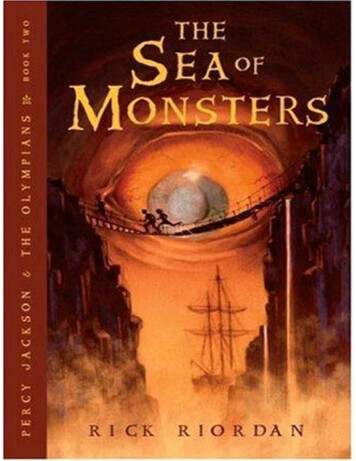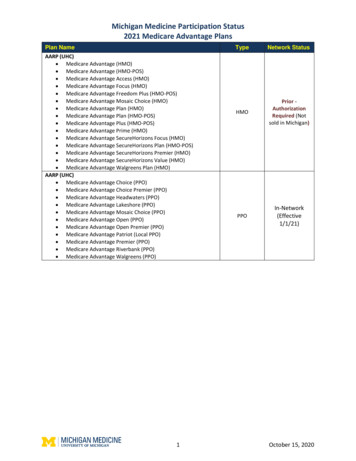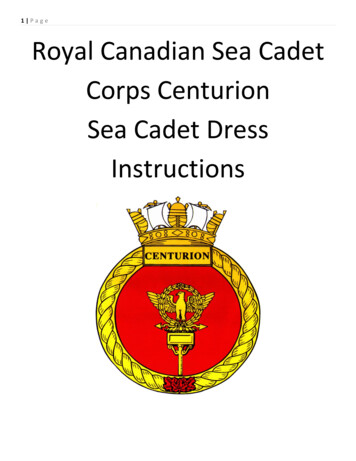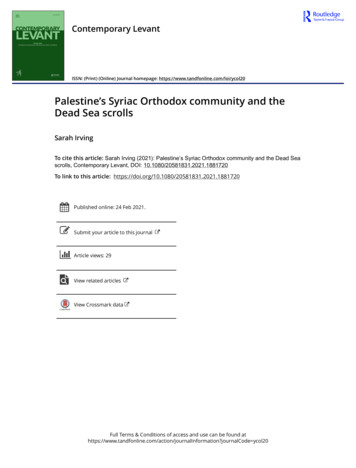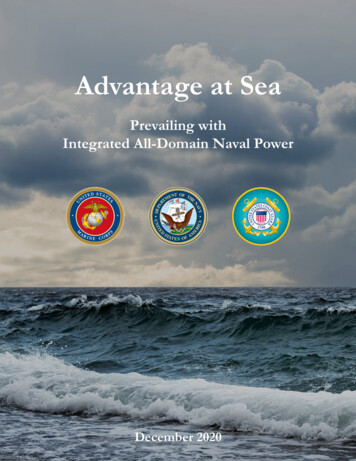
Transcription
Advantage at SeaPrevailing withIntegrated All-Domain Naval PowerDecember 2020
The United States is a maritime nation.Our security and prosperity depend on the seas.The Naval Service—forward deployed and capable of both rapidresponse and sustained operations globally—remains America’smost persistent and versatile instrument of military influence.Integrated All-Domain Naval Power, leveraging thecomplementary authorities and capabilities of the U.S. Navy,Marine Corps, and Coast Guard, advances the prosperity,security, and promise of a free and open, rules-based order.
PREFACETo the American People,It’s been 75 years since our combined Sea Services achieved victory in World War II. Ittook the valor and strength of every Sailor, Marine and Coastguardsman to achieve dominanceon the waves, undersea, and in the skies, projecting strength overseas while protecting ourshores at home. It also took innovation and cooperation within the Naval Service, across theJoint Force, and throughout the industrial base on an unprecedented scale. We won the warthen, and have served side by side ever since, protecting the peace to the great benefit of ourNation, our allies, and the world.As detailed in the following pages, the rules-based international order is once againunder assault. We must prepare as a unified Naval Service to ensure that we are equal to thechallenge. The men and women who wear our uniforms are ready, determined, and dedicatedto serve with honor, courage and commitment. As leaders, it is our responsibility to ensurethey are prepared, equipped, and trained to prevail in long-term strategic competition, win anypotential fight, and preserve the future peace.This strategy details the direction our Service Chiefs have designed together. It isa strong signal of support for our personnel, our allies, and our partners—and a cautionarywarning for any would-be adversaries. We are and will always be one force—Semper Fortis,Semper Fidelis, Semper Paratus—always strong, always faithful, and always ready to protectand defend the United States of America, around the clock and around the world.Very Respectfully,Kenneth J. BraithwaiteSecretary of the Navy
FOREWORDOur actions in this decade will shape the maritime balance of power for the rest of this century.The security environment has dramatically changed since we last published A Cooperative Strategyfor 21st Century Seapower in 2015. Several nations are contesting the balance of power in key regionsand seeking to undermine the existing world order. Significant technological developments and aggressivemilitary modernization by our rivals are eroding our military advantages. The proliferation of long-rangeprecision missiles means the United States can no longer presume unfettered access to the world’s oceansin times of conflict.Since the beginning of the 21st century, our three Sea Services have watched with alarm thegrowing naval power of the People’s Republic of China and the increasingly aggressive behavior of theRussian Federation. Our globally deployed naval forces interact with Chinese and Russian warships andaircraft daily. We witness firsthand their increasing sophistication and growing aggressiveness. Optimismthat China and Russia might become responsible leaders contributing to global security has given way torecognition that they are determined rivals. The People’s Republic of China represents the most pressing,long-term strategic threat.In the midst of fighting two wars, our three Services have worked to meet these global challenges.The Navy has prioritized controlling the seas, increased its forward deployed forces in Asia and Europe,and realigned its warfighting organizations. Today, roughly 60 percent of Navy forces are in the IndoPacific region. Sweeping transformation of the Marine Corps is generating greater expeditionary combatpower with enhanced capabilities for sea control and sea denial. The Coast Guard is expanding its globalengagements and capacity-building efforts in key vulnerable regions. Together, we are developing newoperational concepts and redesigning our forces to provide the capability and capacity to execute them.However, we are not yet where we need to be. Getting there will require predictable budgets and on-timefunding.America’s Naval Service defends our Nation by preserving freedom of the seas, deterring aggression,and winning wars. For generations, we have underwritten security and prosperity and preserved the valuesour Nation holds dear. However, China’s behavior and accelerated military growth place it on a trajectorythat will challenge our ability to continue to do so. We are at an inflection point. Our integrated Navy,Marine Corps, and Coast Guard must maintain clear-eyed resolve to compete with, deter, and, if necessary,defeat our adversaries while we accelerate development of a modernized, integrated all-domain navalforce for the future. Our actions in this decade will shape the maritime balance of power for the rest of thiscentury.Together, we must act with urgency to integrate and modernize our forces as we prepare for thechallenges ahead. The boldness of our actions must match the magnitude of our moment. The security ofour Nation depends on our ability to maintain advantage at sea.David H. BergerMichael M. GildayKarl L. SchultzGeneral, U.S. Marine CorpsCommandant of the Marine CorpsAdmiral, U.S. NavyChief of Naval OperationsAdmiral, U.S. Coast GuardCommandant of the Coast Guard
TABLE OF CONTENTSIntroduction1I. The Security Environment3A Global Competition for Influence3Problem Statement5Implications for the Naval Service6II. Integrated All-Domain Naval Power7III. Employing Naval Forces9Prevailing in Long-Term Strategic Competition9Operating Across the Competition Continuum10In Day-to-Day Competition10In Crisis12In Conflict13IV. Developing Naval Forces15Delivering Integrated All-Domain Naval Forces15Integrating the Naval Service17Conclusion21Annex: Naval Service Investments22Glossary25
TINTRODUCTIONhe United States is a maritime nation. Our security and prosperity depend on the seas.Since the end of World War II, the United States has built, led, and advanced a rulesbased international system through shared commitments with our allies and partners. Forwarddeployed forces of the U.S. Navy, Marine Corps, and Coast Guard—collectively known asthe Naval Service—have guaranteed the security of this system. Free and open access to theworld’s oceans has fostered an extraordinary era of wealth and peace for many nations. Thatsystem is now at risk.Advantage at Sea is a Tri-Service Maritime Strategy that focuses on China and Russia, thetwo most significant threats to this era of global peace and prosperity. We prioritize competitionwith China due to its growing economic and military strength, increasing aggressiveness, anddemonstrated intent to dominate its regional waters and remake the international order in itsfavor. Until China chooses to act as a responsible stakeholder rather than brandish its powerto further its authoritarian interests, it represents the most comprehensive threat to the UnitedStates, our allies, and all nations supporting a free and open system.Other rivals, including Iran, North Korea, violent extremist organizations, andtransnational criminal organizations, also continue to subvert the international rules-basedorder. We will address these challengers in a coordinated, multinational manner with forcesdeveloped to address more significant military threats.The stakes of this competition are high. China’s aggressive actions are undermining theinternational rules-based order, while its growing military capacity and capabilities are erodingU.S. military advantages at an alarming rate. The Naval Service must act with urgency, clarity,and vision to take the bold steps required to reverse these trends.Advantage at Sea provides guidance to the Naval Service for the next decade toprevail across a continuum of competition—composed of interactions with other nations fromcooperation to conflict. This strategy emphasizes the following five themes. We must fullyTen nations, 22 ships, one submarine, and more than 5,300 personnel participate in Exercise Rim of thePacific (RIMPAC) 2020. The biennial exercise is a unique training platform designed to enhance multinationalinteroperability and strategic maritime partnerships. (USN photo by MC2 Dan Bard)Advantage at Sea1
leverage the complementary authorities and capabilities of the Naval Service to generateIntegrated All-Domain Naval Power. We must strengthen our alliances and partnerships—our key strategic advantage in this long-term strategic competition—and achieve unity ofeffort. We must operate more assertively to prevail in day-to-day competition as we upholdthe rules-based order and deter our competitors from pursuing armed aggression. If our rivalsescalate into conflict, becoming our adversaries, we must control the seas to deny theirobjectives, defeat their forces, protect our homeland, and defend our allies. And, we mustboldly modernize the future naval force to maintain credible deterrence and preserve ouradvantage at sea.This strategy connects the Service Chiefs’ statutory roles—developing naval forcesand providing best military advice for employing naval forces. Section I outlines the securityenvironment and the problems that we face. Section II articulates how Integrated All-DomainNaval Power addresses these problems. Section III describes how naval power can be appliedacross the competition continuum in day-to-day competition, crisis, and conflict to achievenational objectives. Section IV guides the development and integration of a modernized, alldomain naval force that will ensure our unfettered access to the seas and reverse our erodingmilitary advantages.The challenges we face require us to make hard choices. This strategy prioritizes ourmost pressing threats, emphasizes expanded cooperation with allies and partners, and relieson deeper Naval Service integration to mitigate strategic risk to the Nation. Additional detailregarding our priorities, capabilities, investments, divestments, and operational approachesis contained in supporting classified guidance, both existing and forthcoming. Advantageat Sea is complemented by separate Service Chief guidance, such as the Chief of NavalOperations’ Navigation Plan, the Commandant of the Marine Corps’ Planning Guidance, andthe Commandant of the Coast Guard’s Strategic Plan.2Advantage at Sea
TI. THE SECURITY ENVIRONMENThe world’s oceans play a vital role in America’s national security and prosperity. The seahas always been a competitive space that has served as both a strategic buffer and a vitalconnection to the world. As strategic competition continues to intensify, our rivals seek toexploit the openness of the maritime domain as they carry out campaigns of coercion andintimidation.The oceans connect global markets, provide essential resources, and link societiestogether. By value, 90 percent of global trade travels by sea, facilitating 5.4 trillion of U.S.annual commerce and supporting 31 million American jobs. Undersea cables transmit 95percent of international communications and roughly 10 trillion in financial transactionseach day. For decades, the free and open international order has produced shared security andprosperity throughout the world.A GLOBAL COMPETITION FOR INFLUENCEToday, the People’s Republic of China (PRC) and the Russian Federation (RF) employall instruments of their national power to undermine and remake the international system toserve their own interests. Each conduct a variety of malign activities incrementally, attemptingto achieve their objectives without triggering a military response. Both nations back theirrevisionist activities with regionally powerful militaries and obscure their aggressive behaviorby mixing military and paramilitary forces with proxies. China’s and Russia’s attempts toexert control over natural marine resources and restrict access to the oceans have negativerepercussions for all nations.China has implemented a strategy and revisionist approach that aims at the heart of theUnited States’ maritime power. It seeks to corrode international maritime governance, denyaccess to traditional logistical hubs, inhibit freedom of the seas, control use of key chokepoints,deter our engagement in regional disputes, and displace the United States as the preferredpartner in countries around the world.To enable its strategy, China deploys a multilayered fleet that includes the People’sLiberation Army Navy, the China Coast Guard, and the People’s Armed Forces MaritimeMilitia—naval auxiliaries disguised as civilian vessels—to subvert other nations’ sovereigntyand enforce unlawful claims. It continues to militarize disputed features in the South ChinaSea and assert maritime claims inconsistent with international law. Its state-subsidized distantwater fishing fleet steals vital resources from nations unable to defend their own exclusiveeconomic zones. To support its multilayered fleet, China is also developing the world’s largestmissile force, with nuclear capabilities, which is designed to strike U.S. and allied forces inGuam and in the Far East with everything from ballistic missiles to maneuverable cruise andhypersonic missiles. Further, China has centralized its robust strategic, space, cyber, electronic,and psychological warfare capabilities.With naval forces as the cornerstone of its efforts, China is aggressively growing andmodernizing its military. Already commanding the world’s largest naval force, the PRC isbuilding modern surface combatants, submarines, aircraft carriers, fighter jets, amphibiousassault ships, ballistic nuclear missile submarines, large coast guard cutters, and polarAdvantage at Sea3
Figure 1: Growth of China’s maritime forces since 2000. (Source: Office of Naval Intelligence)icebreakers at alarming speed. China’s navy battle force has more than tripled in size in onlytwo decades (Figure 1).This rapid growth is enabled by a robust shipbuilding infrastructure, including multipleshipyards that exceed those in the United States in both size and throughput. In conflict, excessPRC industrial capacity, including additional commercial shipyards, could quickly be turnedtoward military production and repair, further increasing China’s ability to generate newmilitary forces.Whereas U.S. naval forces are globally dispersed, supporting U.S. interests anddeterring aggression from multiple threats, China’s numerically larger forces are primarilyconcentrated in the Western Pacific. However, as China seeks to establish regional hegemony,it is also expanding its global reach. China’s One Belt One Road initiative is extending itsoverseas logistics and basing infrastructure that will enable its forces to operate farther from itsshores than ever before, including the polar regions, Indian Ocean, and Atlantic Ocean. Theseprojects often leverage predatory lending terms that China exploits to control access to keystrategic maritime locations.Modernization efforts are also underway in Russia. Its military prioritizes nuclear andadvanced missile systems, attack and guided-missile submarines, bombers, missile frigates,fighter jets, air-to-air missiles, and state-of-the-art air defenses. In conflict, Russia maythreaten cyber or kinetic strikes against Washington or European capitals, or attack underseacommunications cables, causing severe impact to the global economy. It may also gamble thatuse of nuclear weapons might avert defeat in combat or preclude retaliation.4Advantage at Sea
Russia’s operations are designed to fragment the international order. Its pursuit of anexpanded sphere of influence has been defined by opportunism and a willingness to violateinternational agreements and laws, as well as use of military force. Its campaign to restorestrategic depth has motivated RF aggression in Ukraine and Georgia, as well as its interventionin Syria.In the event of conflict, China and Russia will likely attempt to seize territory before theUnited States and its allies can mount an effective response—leading to a fait accompli. Eachsupports this approach through investments in counter-intervention networks. Each seeks toshift the burden of escalation by reinforcing annexed territory with long-range precision-strikeweapons and make a military response to an invasion seem disproportionately costly.Additional competitors, violent extremists, and criminal organizations all exploit weakgovernance at sea, corruption ashore, and gaps in maritime domain awareness. Piracy, drugsmuggling, human trafficking, and other illicit acts leave governments vulnerable to coercion.Climate change threatens coastal nations with rising sea levels, depleted fish stocks, and moresevere weather. Competition over offshore resources, including protein, energy, and minerals,is leading to tension and conflict. Receding Arctic sea ice is opening the region to growingmaritime activity and increased competition. These forces and trends create vulnerabilities foradversaries to exploit, corrode the rule of law, and generate instability that can erupt into crisisin any theater.New and converging technologies will have profound impacts on the securityenvironment. Artificial intelligence, autonomy, additive manufacturing, quantum computing,and new communications and energy technologies could each, individually, generate enormousdisruptive change. In combination, the effects of these technologies, and others, will bemultiplicative and unpredictable. Militaries that effectively integrate them will undoubtedlygain significant warfighting advantages.The United States and its allies will be challenged to build the necessary capabilityand capacity required to address these many threats. Increasingly sophisticated weaponsystems and a shrinking defense industrial base will raise the price and extend the timelines fordeveloping and procuring new weapons and platforms. Continuous budget pressures, includingthe economic impact of COVID-19, may constrain resources available for defense.PROBLEM STATEMENTChina’s and Russia’s revisionist approaches in the maritime environment threaten U.S.interests, undermine alliances and partnerships, and degrade the free and open internationalorder. Moreover, China’s and Russia’s aggressive naval growth and modernization are erodingU.S. military advantages. Unchecked, these trends will leave the Naval Service unpreparedto ensure our advantage at sea and protect national interests within the next decade.Advantage at Sea5
IMPLICATIONS FOR THE NAVAL SERVICEAlliances and partnerships remain our key strategic advantage. Our allies, partners,and alliances such as NATO are an enduring asymmetric advantage over our rivals. Theyuphold international norms, generate naval power, and provide access to valuable strategicmaritime positions. We must strengthen and expand our network of relationships to ensure oursuccess in competition, crisis, and conflict.Activities short of war can achieve strategic-level effects. The maritime domain isparticularly vulnerable to malign behavior below the threshold of war and incremental gainsfrom malign activities can accumulate into long-term advantages. Rivals are exploiting newavenues to advance their interests, including weaponizing social media, infiltrating globalsupply chains, and using space and cyber as warfighting domains. We must compete in thesespaces.Prevailing in competition is more than a conceptual challenge. Countering malignbehaviors short of armed conflict requires sufficient naval capacity and integration to maintainforward presence, as well as targeted capabilities that expand our response options. To sustaindeterrence and prevent competition from escalating into conflict, we must maintain our criticalmilitary advantages.Operating forward deters coercive behavior and conventional aggression. Wecannot build trust and interoperability with our maritime allies and partners from a distance.Nor can we contest malign activities without being present. Our force generation models mustensure we have sufficient combat-credible naval forces available to deter aggression, preempta fait accompli, and win in conflict, all backed up by rapid surge capability and capacity.Contested seas require a renewed emphasis on sea control. Denying our adversaries’use of the seas thwarts their direct wartime objectives and disrupts their efforts to threaten ourallies and the American homeland from the maritime domain. We must increase our emphasis oncontrolling the seas in conflict to provide joint and allied forces with the freedom of maneuverto attack adversary forces and impose costs globally.Maintaining advantage at sea requires modernization. In persistently surveilled,contested environments, agile naval forces offer dynamic and flexible options from whichto project combat power. We must maintain our advantage at sea with new platforms, newthinking, and new technologies that enhance distributed naval operations, and develop ourpeople and culture to meet the challenges of a complex security environment.6Advantage at Sea
TII. INTEGRATED ALL-DOMAINNAVAL POWERhe Navy, Marine Corps, and Coast Guard have a proud heritage of serving and fightingtogether, but today’s security environment demands deeper cooperation. Integrated AllDomain Naval Power—synchronizing the complementary capabilities, capacities, roles,investments, and authorities of the Naval Service—multiplies the traditional influence of seapower to produce a more competitive and lethal total force. Together, we expand our abilityto deliver effects across the competition continuum and in all domains: from the sea floor tospace; across the world’s oceans, littorals, and coastal areas ashore; and in the informationenvironment, cyber domain, and electromagnetic spectrum.Integrated naval forces are uniquely suited for operations across the competitioncontinuum. The Coast Guard’s mission profile makes it the preferred maritime securitypartner for many nations vulnerable to coercion. Integrating its unique authorities—lawenforcement, fisheries protection, marine safety, and maritime security—with Navy andMarine Corps capabilities expands the options we provide to joint force commanders forcooperation and competition. In conflict, Navy-Marine Corps integration expands our abilityto control the seas, as we combine distributed fleet operations and mobile, expeditionaryformations with sea control and sea denial capabilities. These operations are guided by NavalService concepts—Distributed Maritime Operations, Littoral Operations in a ContestedEnvironment, and Expeditionary Advanced Base Operations—that combine the effects ofsea-based and land-based fires, enabling our forces to mass combat power at times andplaces of our choosing. Closer integration allows our forces to distribute more broadly andincrease our operational unpredictability across the competition continuum by varying ourtiming, location, domain, forces, and activities.Naval forces’ unique attributes generate options and decision space for nationalleadership, providing credible deterrence and prompt crisis response worldwide, regardlessof access to overseas bases. Every day, the Naval Service operates on the front lines of globalcompetition, interacting with China’s and Russia’s forces in every domain. Agile, mobile,expeditionary, scalable, sustainable, versatile, networked, and lethal, we provide criticaladvantages over our competitors through our ability to use the vast oceans to maneuverand sustain our forces globally. Working alongside our allies and partners, our operations,exercises, and engagements must set the conditions for a future in which our rivals aredeterred from malign behaviors and aggression—and, if deterrence fails, a future in whichthey are defeated.Multi-mission by design, the Naval Service leaves home port outfitted for theunpredictable. We have crucial peacetime missions, including responding to disasters,preserving maritime security, safeguarding global commerce, protecting human life, andextending American influence. We underwrite the use of global waterways to achieve nationalsecurity objectives through diplomacy, law enforcement, economic statecraft, and, whenrequired, force. We embody America’s resolve, its might, and its commitment to uphold thevalues of a free and open order.Advantage at Sea7
The Naval Service does not compete, deter, or fight alone. We are an integral partof the Joint Force and work closely with allies, partners, and other government agencies.We are also part of America’s broader maritime enterprise, which includes commercialships, merchant mariners, port infrastructure, and shipbuilders. All of these relationships areparamount to guarantee free use of the maritime domain, ensure our security, and protect ourprosperity.Legend-class cutter USCGC Stratton (WMSL 752) and Arleigh Burke-class guided-missile destroyer USSMcCampbell (DDG 85) maneuver in the Coral Sea in 2019. (USN photo by MC2 John Harris)8Advantage at Sea
III. EMPLOYING NAVAL FORCESAPREVAILING IN LONG-TERM STRATEGIC COMPETITIONmerican security objectives have remained broadly consistent since the end of WorldWar II. The United States has sought to protect its territory and secure global conditionshospitable to liberty, commerce, and peace. We have opposed rivals’ attempts to subjugateregions to their control or restrict access to the world’s oceans. Wherever these lasting interestswere threatened, the United States has worked alongside like-minded nations to defend ourcommon goals and change the behavior of nations operating outside established internationalnorms. America’s Navy, Marine Corps, and Coast Guard have served as powerful, visiblesymbols of our commitment to these enduring values.To counter China’s and Russia’s revisionist approaches in the maritime environmentand to set global maritime conditions that support National Defense Strategy objectives, theNaval Service, as part of the Joint Force, will: Defend the homeland from attack and protect the U.S. marine transportation system Preserve a stable and secure global maritime environment that is free, open, andadvances prosperity through transit, trade, and lawful pursuit of natural resources Defend allies from aggression and enable partners to counter coercion and subversion Expand collaboration and interoperability with allies and partners, and reinforcefavorable balances of maritime power Deter strategic, nuclear, conventional, and cyber aggression to protect U.S. vitalinterests In the event of conflict, deny adversaries their objectives, defeat adversary forces whilemanaging escalation, and set the conditions for favorable conflict terminationGiven the scope of our global mission and the scale of our challenges, we must setpriorities and manage risk. We cannot operate everywhere, at all times, with equal effectiveness.Therefore, the Naval Service will prioritize:Competition with the PRC over other challengers. China is the only rival with thecombined economic and military potential to present a long-term, comprehensive challenge tothe United States. Naval Service operations and force posture will focus on countering PRCmalign behavior globally and strengthening regional deterrence in the Indo-Pacific region.Deny competitors strategic gains from malign behavior over minimizing tactical risk.Deterring and contesting incrementalism requires firm and persuasive operations to confrontmalign behavior. Ready, forward-deployed naval forces will accept calculated tactical risksand adopt a more assertive posture in our day-to-day operations.Future warfighting readiness over near-term demand. To preserve our ability tomodernize for the future in a fiscally constrained environment, the integrated Naval Servicewill carefully manage its resources to answer global force demands efficiently.Advantage at Sea9
OPERATING ACROSS THE COMPETITION CONTINUUMThe Naval Service will partner, persist, and prevail across the competitioncontinuum, employing Integrated All-Domain Naval Power through five lines of effort:Advance global maritime security and governance. We will operate with allies,partners, other U.S. agencies, and multinational groups to maintain a free and open maritimeenvironment, and uphold the norms underpinning our shared security and prosperity.Strengthen alliances and partnerships. We will maintain and expand our large anddiverse network of allies and partners. Acting with unity of effort, like-minded-nations generateenormous power to modify behavior in the maritime domain. Allies and partners must be readyand willing to bring capability and capacity to operations across the competition continuum.Confront and expose malign behavior. Together with whole-of-government partners,we will deny the obscurity that our rivals exploit, holding them accountable to the same standardsby which others abide. Exposing and attributing malign behavior imposes reputational costs,diminishes the effectiveness of propaganda, and galvanizes international resistance.Expand information and decision advantage. We will maintain superiority incoordinating, distributing, and maneuvering our forces. We will sense, decide, and act morequickly and effectively than our adversaries. Maintaining decision advantage removesadversary leaders’ sense of control, inducing doubt and increased caution in crisis and conflict.Deploy and sustain combat-credible forces. Forward deployed, combat-credibleforces enable all lines of effort. We will deter potential adversaries from escalating into conflictby making that fight unwinnable for them. Should our adversaries choose the path of war,naval and joint forces will defeat adversary forces and impose global costs by leveraging ourwartime operational concepts.In strategic competition, interactions between our forces and those of our competitorsmay occur at varying levels
Dec 17, 2020 · United States’ maritime power. It seeks to corrode international maritime governance, deny access to traditional logistical hubs, inhibit freedom of the seas, control use of key chokepoints, deter our engagement in regional disputes, and displace the United State
